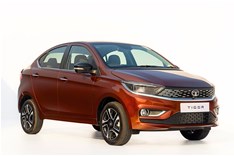2017 Tata Tigor review, test drive
With an emphasis on style, the new Tata Tigor is a refreshingly different take on the compact sedan.
Published on Mar 19, 2017 08:03:00 AM
1,05,233 Views
Follow us on
The Tigor offers good straight-line stability and ride quality is impressive.

Both three-cylinder petrol and diesel engines offer adequate performance but no more. Neither engine is exciting.

The Tigor’s wheelbase is 50mm longer than the Tiago’s. The rear doors and glasshouse is different too.

Only minor details distinguish the Tigor and Tiago till the B-pillar. The Tigor gets projector lenses and a smoked finish for its headlights.
What’s it like to drive?
Like the Tiago, the Tigor will be offered with a 1.05-litre, three-cylinder diesel engine and a 1.2-litre, three-cylinder petrol engine. Both engines come mated to five-speed gearboxes, albeit with shorter gearing to compensate for the 50kg weight increment over the Tiago.
The diesel engine makes 70hp of power and 140Nm of torque, figures which are quite low by segment standards. And the fact is the diesel engine feels adequate, but no more. Performance in town is fair and you’ll be able to keep up with traffic, but when you want to overtake, you’ll miss that mid-range surge we’ve just come to expect from even small turbo-diesels. There is a mild step up in power at 2,000rpm but power delivery remains flat thereafter, forcing you to downshift when you need to get a quick move on. Out on the highway too, you will often be left wanting for power. The diesel engine is also on the noisier side and sounds thrummy when extended. For their part, the gearbox is smooth in operation, though not slick, and the clutch is reasonably light too.
| Tata Tigor Price, Mileage, Specifications, Features and Variants | |
|---|---|
| Brand | Tata |
| Model Name | Tigor |
| Tata Tigor Price | ₹ 6.66 - 10.74 lakh |
| Tata Tigor Range/Mileage | NA |
| Tata Tigor Specifications | Sedan | 4 doors | 5 seats View All Specs |
| Tata Tigor Features | LED headlight | 10.2-inch Touchscreen display | 2 airbags View All Features |
| Tata Tigor Variants | Petrol XM MT | Petrol XT MT | Petrol XT AMT View All Variants |

For most urban buyers though, the petrol Tigor would be the one of greater interest. The petrol Tigor uses the same engine as the one on the Tiago but Tata has added a balancer shaft to cut vibrations here. The inclusion of the balancer also required recalibration of the ECU and the net effect is the engine feels far nicer than it does in the Tiago. Vibrations are significantly reduced and fueling seems cleaner too; power delivery is noticeably smoother than the petrol Tiago. Performance in town is decent with reasonable responses to throttle inputs. Fairly smooth gearshifts and the light clutch also help the experience. Still, the 85hp engine does little to excite. The build-up of power is flat throughout the rev range (it revs until 6,500rpm) and it simply lacks zing. And when revved hard, the engine doesn’t sound particularly nice either.
Both Tigors offer drive modes with ‘City’ being the default setting and an ‘Eco’ setting to enhance fuel economy. While we are yet to test the efficacy of the system we can tell you that the diesel Tigor feels a bit labored in Eco while the petrol version remains usable in the efficiency mode. Tata has not revealed fuel economy figures for the Tigor as yet.
Irrespective of which version of the Tigor you drive, you are sure to like the car for its ride and handling. The steering, for one, is well-weighted – light at low speeds and heavier at high speeds – and operates with a really nice smoothness. When going fast, there’s a good connect with the car and though the Tigor rolls quite a bit in the bends you always feel well in control. The Bridgestone tyres offer good grip in the corners as well as under hard braking. Our top-spec test cars came with anti-lock brakes but it’s not yet clear if ABS will be available on lower variants as well.

Tata’s newer models have scored well for ride comfort and the Tigor is no different. Concentrate hard and you’ll notice minute up and down movements. But in general, the suspension ably deals with the bumps and lumps, with the chunky tyres further absorbing smaller imperfections well. What’s more, the suspension goes about its business without much noise, adding to the Tigor’s big-car feel.
Copyright (c) Autocar India. All rights reserved.





Comments
Member Login
Personal Details
No comments yet. Be the first to comment.